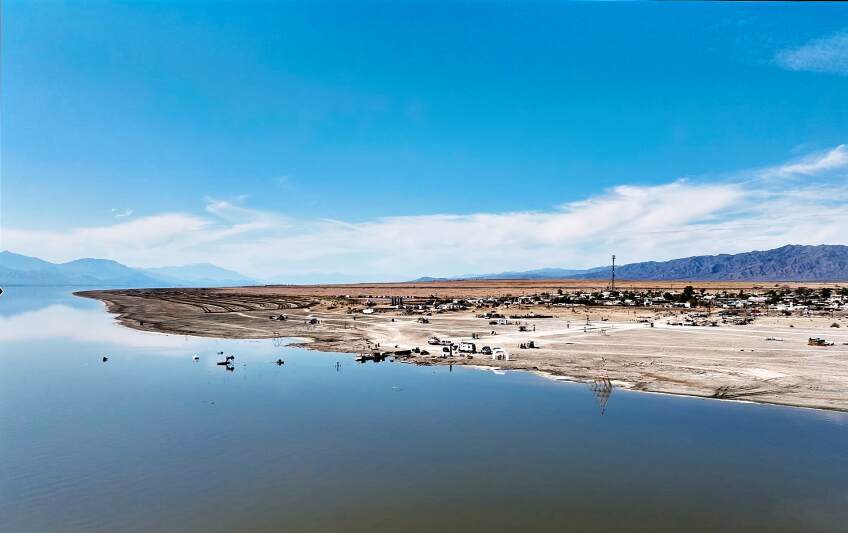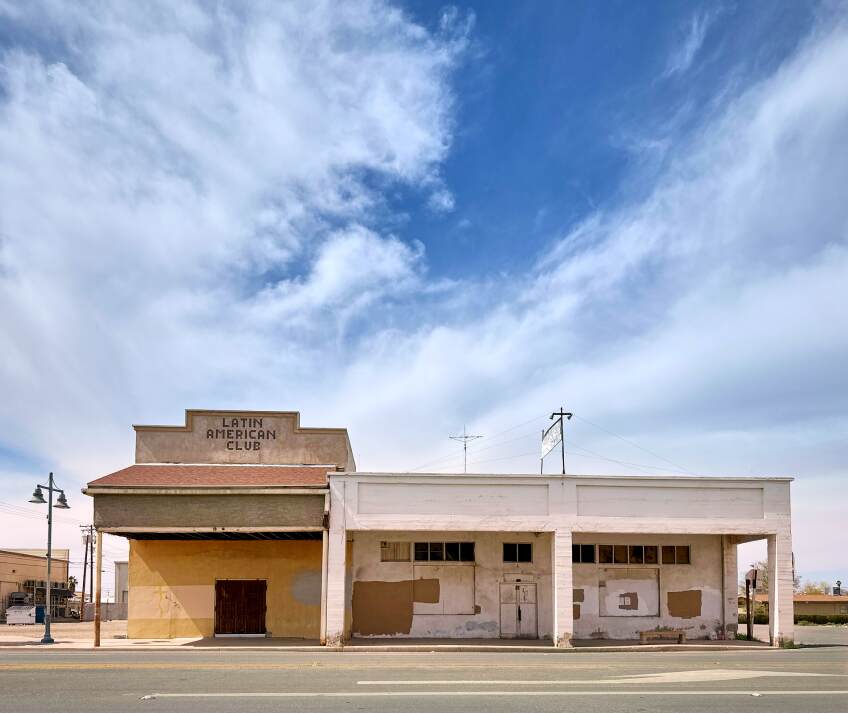The White Snake of Knowledge: A Lithium Boom at the Salton Sea

High & Dry surveys the legacy of human enterprise in the California desert and beyond. Together, writer Jack Eidt and photographer Osceola Refetoff document human activity, past and present, in the context of future development. The first Dispatch in this new series on the Salton Sea focuses on the impending lithium extraction boom.
There is a legend, not well-told, when the [Kamia] people lived there, there was a giant snake that came from the ocean and went into the Salton Sea—a big white snake and it had spots all over it—a repository of knowledge. He surfaced at Obsidian Butte with a boom from the volcanic power from below the Earth. The people saw this happen and knew this was not just a snake...
— Preston Arrow-weed, Quechan/Kamia Knowledge Keeper

When I first experienced Obsidian Butte on the Salton Sea, a place of domed black shiny rock that had erupted into fractured sharp-edged piles by ancient volcanic activity, I could only surmise this was a place of powerful creative forces.
Well, I had my answer when I heard Preston Arrow-weed convey the Kamia creation myth on an environmental justice webinar. The igneous rock formation on this salty, drying desert lake in southeastern California’s Imperial Valley, is part of five lava domes formed by a field of venting fumaroles and hot geothermal springs originating from deep in the Earth.

So maybe it makes sense that multiple corporate entities have targeted this area as their creative solution to our clean renewable energy transition away from fossil fuels through geothermal electricity and what some have called “the lithium revolution.” This “white gold” rush for lithium is in high demand for rechargeable batteries for electric vehicles (EVs), and wind and solar off-peak power storage for your home, your neighborhood, your region.
The extractive frenzy has caused mining booms already in the Puna de Atacama or Atacama Plateau region of Argentina, Chile, and Bolivia; Australia as well. China now produces about 75% of the world’s lithium-ion batteries. The push here in the U.S. is to develop more sustainable sources for lithium domestically.

In this series of dispatches we will investigate the question of whether this “revolution” will be clean or good for the economy in Imperial Valley, which has some of the highest unemployment levels and lowest median incomes in the state. Yet, first we should understand the complexity in the environment of this dramatic, much maligned Salton Sea.
Many depict this lake as an environmental nightmare, formed by an accidental flood in 1905 on newly built irrigation canals from the Colorado River. Now polluted by agricultural runoff and deprived of flow by multiple dams and canals on the Colorado and cutbacks in water allotments, it shrinks every day in the hot sun. Algal blooms have caused fish die-offs and with wetland areas shrinking, migrating birds linger less on the Pacific Flyaway.
Yet, the Salton Sea remains as California’s largest body of water, and its expanse as critical wildlife habitat is still formidable.

Moreover, what some don’t know is since the Colorado River was formed 5 million years ago, the ebb and flow of wet years led to occasional re-routing of the river west to flood the Salton Trough, at about 280 feet below sea level. This created what was known to geologists as the ancient Lake Cahuilla after some of the early inhabitants, the Cahuilla People. Through their oral traditions, related to the Kamia story, the cremation of their Creator produced tears that turned the lake salty.

This biologically rich water-wonderland in wet years would cover an area six times greater than today’s Salton Sea, 350 feet deep. It would take 60 years to dry and die, as the Colorado turned back its flow in dry years into its main channel, emptying in the Gulf of California to the south.
In fact, according to archaeologist Jerry Schaefer, in the last 1,000 years, Lake Cahuilla has filled and receded at least four times. So, we have a natural process of drying estuaries and blowing sand, here manifesting on today’s Salton Sea, without the hope of future floods because of the many dams and cutbacks from the Colorado.

The desiccation of the Salton Sea has hurt the economy of many Riverside and Imperial County communities, so the concept of a clean lithium boom has people making plans. Rechargeable lithium-ion batteries to date have required a water- and land-intensive extraction process that pollutes and destroys, requiring sacrifice zones of the areas hosting the mines.
The effort to cultivate domestic U.S. lithium mining has precipitated environmentally problematic projects proposed at 83 different sites across the Mojave and Great Basin Deserts. So much for a “green” energy revolution, but the word in the renewable energy game is the Salton Sea could be a solution to these miseries.

There are three ways to mine lithium: open pits from hard rock or clay deposits, brine evaporation in massive ponds, or a new technology called Direct Lithium Extraction (DLE). The third way, proposed for the Salton Sea, is the least impactful, but we lack actual scientific studies and technological processes to document this. Different forms of DLE have been undertaken in Argentina, but this is still an experimental undertaking which we will discuss in further detail in subsequent dispatches.

Nevertheless, according to research conducted by the U.S. Department of Energy at the Lawrence Berkeley National Laboratory, the Salton Sea could produce 3,400 kilotons of lithium, enough to support over 375 million EV batteries. There are already 11 geothermal plants pumping superheated brine on the Salton Sea.
Three companies, Controlled Thermal Resources, EnergySource, and Berkshire Hathaway Renewables, are scaling up pilot lithium mining technologies using DLE to integrate with the geothermal, testing whether this is actually a viable, environmentally sustainable effort. And there is an ongoing programmatic environmental review which will quantify the impacts for all these interests.

Getting ahead of these reviews however, Australian-U.S. Controlled Thermal Resources (CTR) has a project called Hell’s Kitchen, now undergoing an environmental permitting process. Namesake of a former local restaurant and dancehall, with unintended irony it nods to the underground power evidenced by Preston Arrow-weed’s Kamia Creation myth.
This is the first of seven planned phases for the $1.85 billion facility that could ultimately cover 7,000 acres. Electric Vehicle producers General Motors and Stellantis have jumped on board, and they have a project labor agreement from labor unions regarding construction jobs. Their Environmental Impact Report was approved earlier this year.

…In a ceremony, the [Kamia People] had to destroy the giant snake who had exploded into the world at Obsidian Butte. They cut off His head and cremated Him. The burning created the Smoke of Knowledge, and that wisdom spread over the lands and the mountains. It is there at Obsidian Butte, there must have been a big giant volcano, that displayed the power of that explosion.
— Preston Arrow-weed, Quechan/Kamia Knowledge Keeper

Unfortunately, Controlled Thermal Resources has not answered the multiple questions put forth by the Lithium Valley Community Coalition. Their members have for years supported the push for lithium development based on the notion that we need this for climate resilience, for the clean energy revolution, and to promote economic development for the region.
However, when we spoke with Christian Torres of the local group Comite Civico del Valle (CCV), he wanted to see the projects "done right by considering the community concerns, in particular impacts to the most affected areas in Bombay Beach, Niland, and Calipatria."

In March of this year, CCV partnered with the national group Earthworks, to issue a joint petition challenging the approval of Hell’s Kitchen. They argued that Imperial County advanced the project despite a deeply flawed Environmental Impact Report that failed to adequately analyze and mitigate impacts related to air quality, hazardous waste, water supply, and Salton Sea degradation (among others). The petition also asserted the County failed to comply with legal requirements for tribal consultation, such as meaningful consultation with affected tribes or requiring tribal-specific mitigation measures.

Another member of the Lithium Valley Coalition, the Imperial Valley Equity and Justice Coalition, has been advocating for a comprehensive, legally deliverable, Community Benefits Agreement.
Time and time again, because our community has one of the highest unemployment rates in the nation, they often pit jobs against our livelihood. They say, 'Oh, this will bring jobs, so that's why you need to accept this in your community.' But we're tired of that. Yes, we need jobs, but there are a lot of residents in our community that don't believe we need to just accept jobs at the expense of our health and the environment and air that we breathe.Daniela Flores, Imperial Valley Equity and Justice Coalition

So, we have what could be an important movement to obtain lithium necessary for the renewable energy transition away from climate-wrecking fossil fuels. We can and will weigh the financial viability of the process and debate the environmental impacts as well as community benefits baked into the multiple projects.
Yet, this is potentially a less-damaging alternative over the many other destructive lithium mining processes deployed around the world. Notwithstanding that, my mind keeps going back to Preston Arrow-weed’s warning that when we mess with the powers from deep in the Earth, there can be unintended consequences.

Maybe we should listen to the council of the elders of the lands in question. Carmen Lucas of the Kwaaymii Laguna Band of Indians advocates that any proposal must consider what she refers to as the Southeast Lake Cahuilla Active Volcanic Cultural District, encompassing that massive underground brine pool heated by magma from the Earth’s core.
That we must protect the important cultural resources involved when developing power plants and lithium mines on previously undisturbed Indigenous Sacred Sites. We who advocate for a Green Revolution, those boosters who seek new economic development opportunities, and of course the politicians and governmental entities responsible for safe communities, would ignore these voices at all our peril.
High & Dry will explore the future of the Salton Sea and the people who live there in a series of upcoming dispatches.

Explore more High & Dry on PBS SoCal or visit the our High & Dry website. We welcome your questions and comments.




